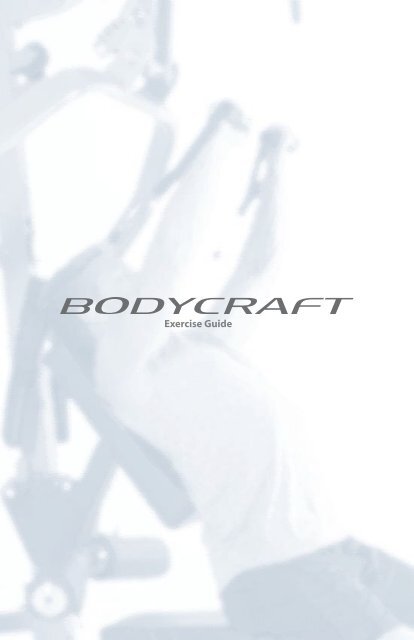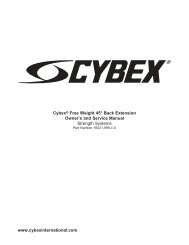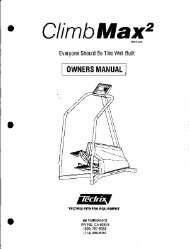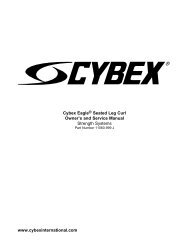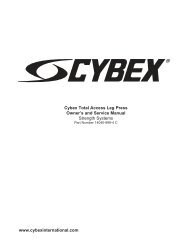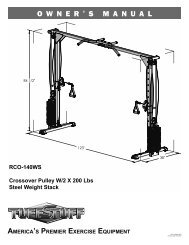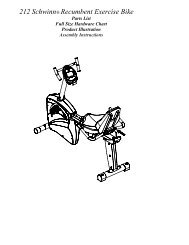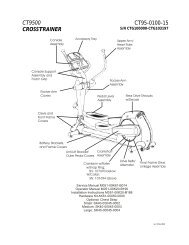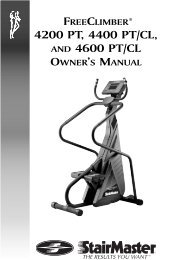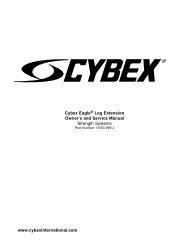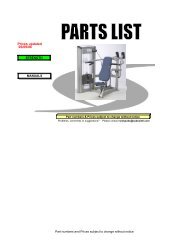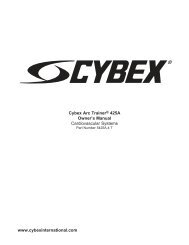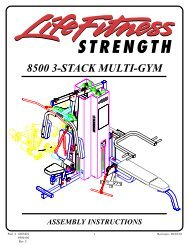BodyCraft Exercise Guide - Helisports
BodyCraft Exercise Guide - Helisports
BodyCraft Exercise Guide - Helisports
You also want an ePaper? Increase the reach of your titles
YUMPU automatically turns print PDFs into web optimized ePapers that Google loves.
<strong>Exercise</strong> <strong>Guide</strong>
Table of Contents<br />
Introduction....................................................................................1<br />
Chest....................................................................................3<br />
Shoulders..................................................................................17<br />
Back..................................................................................29<br />
Arms...................................................................................37<br />
Core..................................................................................46<br />
Legs..................................................................................51<br />
Sports Specific / Functional..........................................................60
INTRODUCTION<br />
CONGRATULATIONS! With your purchase of this BODYCRAFT<br />
Strength Training System you have taken a major step toward a goal of lifetime<br />
health and wellness.<br />
THANK YOU! BODYCRAFT is proud to be a part of your pursuit of<br />
health, wellness, and strength! Please use this BODYCRAFT Strength<br />
Training System to:<br />
• Look better!<br />
• Feel better!<br />
• Maintain bone health!<br />
• Help control your weight!<br />
• Increase your strength!<br />
This book is meant to give you the basic knowledge needed to achieve these<br />
goals. This book is included with several of our models, so the descriptions<br />
and pictures may not exactly match the machine you have bought. The<br />
exercises described can all be performed on your machine, although in some<br />
cases, only if you have purchased optional attachments.<br />
We have included descriptions of 52 different strength training exercises<br />
along with several different variations of almost every exercise. We encourage<br />
you to always seek further knowledge. <strong>Exercise</strong> science is always moving<br />
forward and good new ideas are inevitable.<br />
WARNING! Before beginning this, or any exercise program, consult your<br />
physician. This is especially important for persons over the age of 35, or<br />
with preexisting health problems. You may have a preexisting health problem<br />
of which you are unaware. Recreation Supply, Inc. assumes no responsibility<br />
for personal injury or property damage sustained by or through use of<br />
this product.<br />
1
FUNCTIONAL TRAINING ARMS<br />
BODYCRAFT was the first company to incorporate Functional Training<br />
Arms into the standard multi-function home gym. This extremely versatile<br />
station opened up a vast array of exercises and we cannot imagine making a<br />
home strength training system without it. Your Functional Training Arms<br />
provide exercises that pertain to everyday living. You can train specifically<br />
for your favorite sport or activity, or for tasks required to help make it<br />
through your day. We encourage you to be inventive with your Functional<br />
Training Arms. You can easily invent motions unique to you. Just be careful<br />
to always be in control and work to balance your body.<br />
GENERAL EXERCISE GUIDELINES<br />
There are many theories as to the proper number of repetitions and sets<br />
of repetitions recommended for any specific exercise. In fact, we are all<br />
unique individuals and what may be effective for one person may not be as<br />
effective for another. Your genetic makeup, goals, and available time are all<br />
specific to you. In addition to reading this book, we recommend consultations<br />
with<br />
fitness professionals such as a certified personal trainer and your local specialty<br />
fitness dealer.<br />
The human body is a highly adaptive machine. It can quickly adjust to<br />
routine stresses. Therefore, intensity and variety are vital components of<br />
any strength training routine. Intensity is more important than a specific<br />
number of repetitions or sets of repetitions. The amount a muscle group<br />
is stressed (to failure) is directly proportional to the amount of increased<br />
strength / growth. In other words, the more effort you put into training,<br />
the more results you should receive! Periodically changing the routine is<br />
also highly recommended. Your body will become accustomed to a routine.<br />
Variety will increase your results!<br />
Please remember to start easy and increase the total time and number of<br />
repetitions gradually. Overdoing it in the beginning can cause unnecessary<br />
muscle soreness. If at any time you feel excessive or unnatural pain, stop<br />
immediately! Determine what is wrong before continuing. See your<br />
physician if you have any doubts.<br />
In general terms, for maximum muscle building, we recommend 6-12<br />
repetitions and 2-3 sets per exercise. For endurance training, We recommend<br />
12- 20 repetitions and 2-3 sets per exercise.<br />
2
Chest<br />
3
CHEST<br />
Bench Press<br />
Adjust the seat back to the upright position. Adjust the seat so that the<br />
bench press handles are even with your chest. The bench press handles<br />
should be adjusted for a comfortable stretch, about even with the front<br />
of your chest. Too far back can cause excessive strain on your shoulders!<br />
Grab the handles with an overhand grip and press away from<br />
your chest. Do not lock out your elbows. Return slowly.<br />
Variations: Use an underhand grip or a neutral grip. Changing the<br />
grip does emphasize different areas of the muscle group.<br />
Primary muscles worked: Pectorals Major and Minor (chest), Anterior<br />
Deltoids (shoulder), Triceps (back of the arm).<br />
4
CHEST<br />
Cable Bench Press<br />
Adjust the seat back to the upright position and the Functional Training<br />
Arms to chest height. Sit upright, grab the cable handles with an<br />
overhand grip, and press away from your chest. Return slowly.<br />
Variations: Use an underhand grip, neutral grip, or even twist your<br />
wrists (like a karate punch). You can also vary the width of the Functional<br />
Training Arms. Changing the grip and width does emphasize<br />
different areas of the muscle group. As with all cable oriented exercises,<br />
this exercise can be performed one arm at a time.<br />
Primary muscles worked: Pectorals Major and Minor (chest), Anterior<br />
Deltoids (shoulder), Triceps (back of the arm).<br />
5
CHEST<br />
Converging Bench Press<br />
This exercise is very similar to the Cable Bench Press, but your arms<br />
converge to the middle as you press. Adjust the seat back to the upright<br />
position and the Functional Training Arms to chest height. Sit upright,<br />
grab the cable handles with an overhand grip, and press away from your<br />
chest. Return slowly.<br />
Variations: Use an underhand grip, neutral grip, or even twist your<br />
wrists (like a karate punch). You can also vary the width of the Functional<br />
Training Arms. Changing the grip and width does emphasize different<br />
areas of the muscle group.<br />
Primary muscles worked: Pectorals Major and Minor (chest), Anterior<br />
Deltoids (shoulder), Triceps (back of the arm).<br />
6
CHEST<br />
Incline Bench Press<br />
Adjust the seat back to one of the holes in the INCLINE position. Your<br />
comfort will determine which hole exactly. Adjust the seat so that the<br />
bench press handles are even with your chest. Sit back in the seat so<br />
that the seat back forces a forward lean. The bench press handles should<br />
be adjusted for a comfortable stretch, about even with the front of your<br />
chest. Too far back can cause excessive strain on your shoulders! Grab<br />
the handles with an overhand grip and press away from your chest.<br />
Return slowly.<br />
Variations: Use an underhand grip, or neutral grip. Changing the grip<br />
does emphasize different areas of the muscle group.<br />
Primary muscles worked: Pectorals Major and Minor (chest), Anterior<br />
Deltoids (shoulder), Triceps (back of the arm).<br />
7
CHEST<br />
Cable Incline Bench Press<br />
Adjust the seat back to the upright position and the Functional Training<br />
Arms to chest height. Grab the cable handles with an overhand<br />
grip and press away from your chest, and upward at about a 45 degree<br />
angle. Do not lock out your elbows. Return slowly.<br />
Variations: Use an underhand grip, neutral grip, or even twist your<br />
wrists (like a karate punch). You can also vary the width of the Functional<br />
Training Arms. Changing the grip and width does emphasize<br />
different areas of the muscle group. As with all cable oriented exercises,<br />
this exercise can be performed one arm at a time.<br />
Primary muscles worked: Pectorals Major and Minor (chest), Anterior<br />
Deltoids (shoulder), Triceps (back of the arm).<br />
8
CHEST<br />
Converging Incline Press<br />
This exercise is very similar to the Cable Incline Bench Press, but your<br />
arms converge to the middle as you press. Adjust the seat back to the<br />
upright position and the Functional Training Arms to chest height.<br />
Grab the cable handles with an overhand grip and press away from<br />
your chest, upward at about a 45 degree angle, while bringing your<br />
hands together. Return slowly.<br />
Variations: Use an underhand grip, neutral grip, or even twist your<br />
wrists (like a karate punch). You can also vary the width of the Functional<br />
Training Arms. Changing the grip and width does emphasize<br />
different areas of the muscle group. As with all cable oriented exercises,<br />
this exercise can be performed one arm at a time.<br />
Primary muscles worked: Pectorals Major and Minor (chest), Anterior<br />
Deltoids (shoulder), Triceps (back of the arm).<br />
9
CHEST<br />
Decline Bench Press<br />
Adjust the seat back to the SHOULDER position. Adjust the seat<br />
so that the bench press handles are even with your chest. Sit on the<br />
very front of the seat and lean back into the machine. The bench press<br />
handles should be adjusted for a comfortable stretch, about even with<br />
the front of your chest. Too far back can cause excessive strain on your<br />
shoulders! Grab the handles with an overhand grip and press away<br />
from your chest. Do not lock out your elbows. Return slowly.<br />
Variations: Use an underhand grip, or neutral grip. Changing the grip<br />
does emphasize different areas of the muscle group.<br />
Primary muscles worked: Pectorals Major and Minor (chest), Anterior<br />
Deltoids (shoulder), Triceps (back of the arm).<br />
10
CHEST<br />
Cable Decline Bench Press<br />
Adjust the seat back to one of the holes in the INCLINE position.<br />
Your comfort will determine which hole exactly. Adjust the Functional<br />
Training Arms to chest height. Sit back in the seat so that the seat<br />
back forces a forward lean. Grab the cable handles with an overhand<br />
grip and press away from your chest, parallel to the floor. Return<br />
slowly.<br />
Variations: Use an underhand grip, neutral grip, or even twist your<br />
wrists (like a karate punch). You can also vary the width of the Functional<br />
Training Arms. Changing the grip and width does emphasize<br />
different areas of the muscle group. As with all cable oriented exercises,<br />
this exercise can be performed one arm at a time.<br />
Primary muscles worked: Pectorals Major and Minor (chest), Anterior<br />
Deltoids (shoulder), Triceps (back of the arm).<br />
11
CHEST<br />
Converging Decline Bench Press<br />
This exercise is very similar to the Cable Decline Press, but your arms<br />
converge to the middle as you press. Adjust the seat back to one of the<br />
holes in the INCLINE position. Your comfort will determine which hole<br />
exactly. Adjust the Functional Training Arms to chest height. Sit back<br />
in the seat so that the seat back forces a forward lean. Grab the cable<br />
handles with an overhand grip and press away from your chest, parallel to<br />
the floor, while converging to the middle. Return slowly.<br />
Variations: Use an underhand grip, neutral grip, or even twist your<br />
wrists (like a karate punch). You can also vary the width of the Functional<br />
Training Arms. Changing the grip and width does emphasize<br />
different areas of the muscle group. As with all cable oriented exercises,<br />
this exercise can be performed one arm at a time.<br />
Primary muscles worked: Pectorals Major and Minor (chest), Anterior<br />
Deltoids (shoulder), Triceps (back of the arm).<br />
12
CHEST<br />
Self Stabilizing Chest Press<br />
This exercise targets the chest muscles, but because it is done without back<br />
support, the core stabilizing muscles are also engaged. You will need to<br />
use a much lower weight than standard bench press exercises.<br />
Adjust the seat back to the upright position and the Functional Training<br />
Arms to chest height. Sit forward on the seat, without back support.<br />
Grab the cable handles with an overhand grip and press away from your<br />
chest. Return slowly.<br />
Variations: Use an underhand grip, neutral grip, or even twist your wrists<br />
(like a karate punch). You can also vary the width of the Functional<br />
Training Arms. Changing the grip and width does emphasize different<br />
areas of the muscle group.<br />
Primary muscles worked: Pectorals Major and Minor (chest), Anterior<br />
Deltoids (shoulder), Triceps (back of the arm).<br />
13
CHEST<br />
Cable Pec Fly<br />
Adjust the seat back to one of the holes in the incline position. Adjust<br />
the Functional Training Arms to their widest position. Sit forward<br />
on the seat and lean back into the machine. Grab the handles with<br />
a neutral grip and bring your arms together in a circular motion.<br />
Return slowly.<br />
Variations: As with all cable oriented exercises, this exercise can be<br />
performed one arm at a time.<br />
Primary muscles worked: Pectorals Major and Minor (chest), Anterior<br />
Deltoids (shoulder).<br />
14
CHEST<br />
Cable Incline Fly<br />
Adjust the seat back to the upright position. Adjust the Functional<br />
Training Arms to their widest position. Sit upright on the seat and<br />
grab the handles with a neutral grip. Bring your arms together and<br />
upward in a circular motion. Return slowly.<br />
Variations: As with all cable oriented exercises, this exercise can be<br />
performed one arm at a time.<br />
Primary muscles worked: Pectorals Major and Minor (chest), Anterior<br />
Deltoids (shoulder).<br />
15
CHEST<br />
Cable Low Fly<br />
Adjust the seat back to the vertical position. Adjust the Functional<br />
Training Arms to a low position, either holes 4, 5, or 6. Sit upright<br />
on your machine and grab the handles. Bring your arms up, and<br />
together, to chest height. Return slowly.<br />
Variations: As with all cable oriented exercises, this exercise can be<br />
performed one arm at a time.<br />
Primary muscles worked: Pectorals Major and Minor (chest), Anterior<br />
Deltoids (shoulder), Triceps (back of the arm).<br />
16
Shoulders<br />
17
SHOULDERS<br />
Shoulder Press<br />
Adjust the seat back to one of the holes in the SHOULDER position.<br />
Your personal comfort will determine which hole. Adjust the Press<br />
Arm to one of the holes in the SHOULDER position. Finally, adjust<br />
the seat so that the press handles are at shoulder height. Sit back in<br />
the seat so that the seat back forces a forward lean. The idea is to<br />
align your body with the path of motion of the press arm, so that you<br />
are actually pushing the press handles overhead. Grab the handles<br />
with an overhand grip and press away from your shoulders. Do not<br />
lock out your elbows. Return slowly.<br />
Primary muscles worked: Deltoids (shoulder), Triceps (back of arm).<br />
18
SHOULDERS<br />
Cable Shoulder Press<br />
Adjust the seat back to the most upright position. Adjust the Functional<br />
Training Arms to a vertical position. Adjust the seat so that the cable<br />
handles are at shoulder level. Grab the handles with an overhand grip and<br />
press your arms overhead. Do not lock out your elbows. Return slowly.<br />
Variations: Use a neutral grip, or even twist your wrists (like a karate<br />
punch). You can also vary the width of the Functional Training Arms.<br />
Changing the grip and width does emphasize different areas of the muscle<br />
group. As with all cable oriented exercises, this exercise can be performed<br />
one arm at a time.<br />
Primary muscles worked: Deltoids (shoulder), Triceps (back of arm).<br />
19
SHOULDERS<br />
Converging Shoulder Press<br />
This exercise is very similar to the Cable Shoulder Press, except that<br />
you bring your arms together during the movement. Adjust the seat<br />
back to the most upright position. Adjust the Functional Training<br />
Arms to a vertical position. Adjust the seat so that the cable handles<br />
are at shoulder level. Grab the handles with an overhand grip and<br />
press your arms overhead. Lower slowly.<br />
Variations: Use a neutral grip, or even twist your wrists (like a karate<br />
punch). You can also vary the width of the Functional Training<br />
Arms. Changing the grip and width does emphasize different areas<br />
of the muscle group.<br />
Primary muscles worked: Deltoids (shoulder), Triceps (back of arm).<br />
20
SHOULDERS<br />
Cable Lateral Raise<br />
Adjust the Functional Training Arms to a low position, about shoulder<br />
width apart. Sit upright on the seat and grab the cable handles with a<br />
neutral grip. While keeping your arms straight, raise your hands outward<br />
and upward. Lower slowly.<br />
Variations: Use an underhand grip. As with all cable oriented exercises,<br />
this exercise can be performed one arm at a time.<br />
Primary muscles worked: Deltoids (shoulder).<br />
21
SHOULDERS<br />
Cable Front Raise<br />
Adjust the Functional Training Arms to a low position, about shoulder<br />
width apart. Sit upright on the seat and grab the cable handles<br />
with an overhand grip. While keeping your arms straight, raise your<br />
hands forward and upward. Lower slowly.<br />
Variations: Use an underhand grip, or neutral grip. As with all<br />
cable oriented exercises, this exercise can be performed one arm at a<br />
time.<br />
Primary muscles worked: Deltoids (shoulder).<br />
22
SHOULDERS<br />
Standing Cable Lateral Raise<br />
Adjust one Functional Training Arm to a low position. Stand next to<br />
the Functional Training Arm and grab the handle with an overhand grip.<br />
While keeping your arm straight, raise your hand outward and upward.<br />
Lower slowly.<br />
Primary muscles worked: Deltoids (shoulder).<br />
23
SHOULDERS<br />
Standing Front Raise<br />
It is important to use the supplied length of chain on this exercise.<br />
Otherwise, the weight stack can easily “top out” and damage a<br />
pulley. Attach the chain to the low pulley (on some models, this<br />
may be at the front of the leg extension lever), and then attach the<br />
straight bar to the end of the chain. Stand facing away from the<br />
machine, straddling the chain. While keeping your arms straight,<br />
raise the bar forward and upward to chest height. Lower slowly.<br />
Primary muscles worked: Deltoids (shoulder).<br />
24
SHOULDERS<br />
Upright Row<br />
It is important to use the supplied length of chain on this exercise.<br />
Otherwise, the weight stack can easily “top out” and damage a pulley.<br />
Attach the chain to the low pulley station (on some models, this<br />
may be at the front of the leg extension lever), and then attach the<br />
straight bar to the end of the chain. Stand facing the machine, close<br />
to the low pulley. In the starting position, the straight bar should<br />
be at arms’ length. Pull the bar upward to shoulder level. Lower<br />
slowly.<br />
Primary muscles worked: Deltoids (shoulder), Trapezius (upper<br />
back).<br />
25
SHOULDERS<br />
Shrugs<br />
Attach the straight bar to the low pulley (on some models, this may<br />
be at the front of the leg extension lever). Stand on the foot plate<br />
and hold the bar at arms’ length. “Shrug” your shoulders upward<br />
and rearward. Lower slowly.<br />
Primary muscles worked: Trapezius (upper back), Deltoids (shoulder).<br />
26
SHOULDERS<br />
External Rotator<br />
Stand beside your machine and adjust the Functional Training Arm to<br />
elbow height. For some, this exercise is more comfortable if you place<br />
a rolled up towel under your upper arm. Grasp the handle, using a<br />
neutral grip, with your outside arm. Rotate your arm, as if it were an<br />
opening door, away from your midsection. Return slowly.<br />
Primary muscles worked: Rear Deltoids (shoulder), Rotator Cuff.<br />
27
SHOULDERS<br />
Internal Rotator<br />
Stand beside your machine and adjust the Functional Training Arm to<br />
elbow height. For some, this exercise is more comfortable if you place<br />
a rolled up towel under your upper arm. Grasp the handle, using a<br />
neutral grip, with your inside arm. Rotate your arm, as if it were a<br />
closing door, toward your midsection. Return slowly.<br />
Primary muscles worked: Deltoids (shoulder), Rotator Cuff.<br />
28
Back<br />
29
BACK<br />
Lat Pull Down<br />
Adjust the seat to its lowest position. Attach the lat bar to the high<br />
pulley. Sit facing the machine and lock your knees under the knee<br />
hold-down pads. Grab the lat bar with a wide, overhand grip. Keep<br />
your upper body stationary and pull straight down to your upper<br />
chest. Return slowly.<br />
Variations: Use an underhand grip. Use a narrow grip. You can<br />
perform this exercise one arm at a time using a single handle in place<br />
of the straight bar.<br />
Primary muscles worked: Latissimus Dorsi (mid back), Rhomboideus<br />
(upper back), Trapezius (upper back), Biceps (front of arm).<br />
30
BACK<br />
Low Cable Row<br />
Attach the straight bar to the low pulley. Sit on the floor facing the<br />
low pulley, feet on foot plate (against leg extension pads for GXP).<br />
Keep your upper torso stationary and pull the straight bar to your<br />
midsection. Squeeze your shoulder blades together. Return slowly.<br />
Variations: Use an underhand grip. Use a wide grip with the lat bar.<br />
Attach both single handles for a narrow, neutral grip.<br />
Primary muscles worked: Latissimus Dorsi (mid back), Rhomboideus<br />
(upper back), Trapezius (upper back), Rear Deltoids (rear shoulders),<br />
Biceps (front of arm).<br />
31
BACK<br />
Mid Row<br />
Adjust the press arm to its furthest rear position. Adjust the seat so that<br />
the press handles align with your shoulders. Adjust the seat back outward<br />
as far as possible, so that the handles are at arms’ length. Grab the<br />
handles with an overhand grip and pull back as far as possible. Squeeze<br />
your shoulder blades together. Return slowly.<br />
Variations: Use an underhand grip.<br />
Primary muscles worked: Latissimus Dorsi (mid back), Rhomboideus<br />
(upper back), Trapezius (upper back), Rear Deltoids (rear shoulders),<br />
Biceps (front of arm).<br />
32
BACK<br />
One Arm Row<br />
Adjust one Functional Training Arm to its lowest position. Stand aside<br />
the machine facing the Functional Training Arm and bend at the waist,<br />
holding on to the seat pad for support. Grasp the single handle with a<br />
neutral grip and pull to midsection. Return slowly.<br />
Primary muscles worked: Latissimus Dorsi (mid back), Rhomboideus<br />
(upper back), Trapezius (upper back), Biceps (front of arm).<br />
33
BACK<br />
Front Lat Pullover<br />
Although the picture does not show this, you may need to use the<br />
supplied length of chain on this exercise. Otherwise, the weight stack<br />
can easily “top out” and damage a pulley. Attach the chain to the high<br />
pulley, and then attach the straight bar to the end of the chain. Grab<br />
the straight bar with an overhand grip. Keep your arms straight and<br />
pull down. Return slowly.<br />
Variations: Use an underhand grip.<br />
Primary muscles worked: Latissimus Dorsi (mid back), Rhomboideus<br />
(upper back), Trapezius (upper back), Biceps (front of arm).<br />
34
BACK<br />
Seated Cable Mid Row<br />
Attach the straight bar to the Mid Pulley. Sit facing the machine<br />
and leaning back slightly. Grab the curl bar with an overhand grip<br />
and pull back as far as possible. Return slowly. Keep your upper<br />
torso stationary!<br />
Variations: Use an underhand grip.<br />
Primary muscles worked: Latissimus Dorsi (mid back), Rhomboideus<br />
(upper back), Trapezius (upper back), Biceps (front of arm).<br />
35
BACK<br />
Self Stabilizing Mid Row<br />
Attach the straight bar to the mid pulley. Stand in front of the machine<br />
and grab the straight bar with an overhand grip. Pull the bar back as far<br />
as possible. Return slowly.<br />
Variations: Use an underhand grip.<br />
Primary muscles worked: Latissimus Dorsi (mid back), Rhomboideus<br />
(upper back), Trapezius (upper back), Rear Deltoids (rear shoulders),<br />
Biceps (front of arm).<br />
36
Arms<br />
37
ARMS<br />
Cable Arm Curl<br />
Adjust the seat back to the upright position and the Functional Training<br />
Arms to their lowest position. Sit upright on the seat and grasp the<br />
handles with an underhand grip. Try to keep your elbows and upper<br />
arm stationary while you curl the handles upward, using your biceps<br />
muscles. Lower slowly.<br />
Variations: Use an overhand grip, neutral grip, or even twist your<br />
wrists. You can also vary the width of the Functional Training Arms.<br />
Changing the grip and width does emphasize different areas of the<br />
muscle group. As with all cable oriented exercises, this exercise can be<br />
performed one arm at a time.<br />
Primary muscles worked: Biceps (front of arm), Brachioradials (forearms).<br />
38
ARMS<br />
Standing Bar Curl<br />
It is important to use the supplied length of chain on this exercise.<br />
Otherwise, the weight stack can easily “top out” and damage a<br />
pulley. Attach the chain to the low pulley station (on some models,<br />
this may be at the front of the leg extension lever), and then<br />
attach the Straight Bar to the end of the chain. Stand in front of the<br />
low pulley with the straight bar at arms’ length. Try to keep your<br />
elbows and upper arm stationary while you curl the bar upward, using<br />
your biceps muscles. Lower slowly. NOTE: You can use either<br />
the stationary low pulley, or the Functional Training Arm pulley.<br />
The weight ratio for the stationary low pulley is 1:1 (10 pound<br />
increments to 200 pounds). The weight ratio for the Functional<br />
Training Arms pulley is .5:1 (5 pound increments to 100 pounds).<br />
Variations: Use an overhand grip.<br />
Primary muscles worked: Biceps (front of arm), Brachioradials<br />
(forearms).<br />
39
ARMS<br />
Overhead Biceps Curl<br />
Attach the straight bar to the high pulley. Sit facing the machine and<br />
lock your knees under the knee hold-down pads. Grab the straight bar<br />
with an underhand grip. Concentrate on keeping your upper arm stationary<br />
while curling the straight bar behind your head. Return slowly.<br />
Primary muscles worked: Biceps (front of arm), Brachioradials (forearms).<br />
40
ARMS<br />
Arm Curl From Mid Pulley<br />
Sit facing back of machine. Using straight bar pull from mid pulley<br />
towards face while leaning backwards.<br />
41
ARMS<br />
Triceps Pushdown<br />
It is important to use the supplied length of chain on this exercise.<br />
Otherwise, the weight stack can easily “top out” and damage a pulley.<br />
Attach the chain to the high pulley and then attach the straight<br />
bar to the end of the chain. Stand in front of the high pulley and<br />
grab the straight bar with an overhand grip. Pull the bar downward<br />
to a point where you can lock your elbows at your sides. The<br />
motion is the opposite of an arm curl; push downward on the bar,<br />
flexing at the elbow. Return slowly. Use a full range of motion.<br />
Variations: Use an underhand grip. You can perform this exercise<br />
one arm at a time using a single handle in place of the straight bar.<br />
Primary muscles worked: Triceps (back of arm), Brachioradials<br />
(forearms).<br />
42
ARMS<br />
Triceps Extension<br />
Attach the straight bar to the mid pulley. Sit upright in the seat and<br />
grab the straight bar with an overhand grip. Try to hold your upper<br />
arm locked into a horizontal position while extending your lower<br />
arm at the elbow. Return slowly.<br />
Variations: Use an underhand grip. You can perform this exercise<br />
one arm at a time using a single handle in place of the straight bar.<br />
Primary muscles worked: Triceps (back of arm), Brachioradials<br />
(forearms).<br />
43
ARMS<br />
Triceps Extension From High Pulley<br />
Attach the straight bar to the high pulley. Sit in the seat leaning slightly<br />
forward and grab the straight bar with an overhand grip. Try to hold<br />
your upper arm locked into a horizontal position while extending your<br />
lower arm at the elbow. Return slowly.<br />
Variations: Use an underhand grip. You can perform this exercise one<br />
arm at a time using a single handle in place of the straight bar.<br />
Primary muscles worked: Triceps (back of arm), Brachioradials (forearms).<br />
44
ARMS<br />
Triceps Kickback<br />
Attach a single handle to a Functional Training Arm and adjust it to<br />
a low position. Stand beside the machine in front of the Functional<br />
Training Arm. Bend at the waist to near horizontal. Grab the single<br />
handle with a neutral grip. Try to lock your upper arm at your side<br />
while extending your lower arm at the elbow. Return slowly.<br />
Variations: Use an underhand or overhand grip.<br />
Primary muscles worked: Triceps (back of arm), Brachioradials<br />
(forearms).<br />
45
CHEST<br />
Core<br />
46
CORE<br />
Ab Crunch<br />
Adjust the seat to the lowest position and the seat back to the upright<br />
position. Attach the ab strap to the cable end located behind your head.<br />
Drape the ab strap over your shoulders and hold it in place. Use your<br />
abdominal muscles to crunch forward and downward. Return slowly.<br />
Primary muscles worked: Abdominals (stomach).<br />
47
CORE<br />
Reverse Crunch (Seated Knee Raise)<br />
Sit on the seat and grasp the handles, or sides of seat. Extend your legs to a<br />
horizontal position. Draw your knees toward your chest. Return slowly.<br />
Primary muscles worked: Abdominals (stomach).<br />
48
CORE<br />
Oblique Twist<br />
Adjust one Functional Training Arm to its highest position and stand<br />
aside of it. Grab the handle and pull it to your stomach. Hold the<br />
handle stationary. Lock your hips into place and twist your upper<br />
torso. Return slowly.<br />
Primary muscles worked: Obliques (waist), Abdominals (stomach).<br />
49
CORE<br />
Side Bends<br />
Adjust one Functional Training Arm to its lowest position and stand<br />
aside of it. Grab the handle and hold it stationary at your side. Lock<br />
your hips into place and bend your upper torso to the opposite side.<br />
Return slowly.<br />
Primary muscles worked: Obliques (waist), Abdominals (stomach).<br />
50
Legs<br />
51
LEGS<br />
Leg Extension<br />
Adjust the seat and the seat back so that, when seated, your knees are<br />
aligned with the pivot point on the leg extension lever arm. Sit and<br />
hook your ankles behind the lower roller pads. Grasp the handles, or<br />
the sides of the seat, and extend your legs to horizontal. Return slowly.<br />
Variations: One leg at a time.<br />
Primary muscles worked: Quadriceps (front of upper leg)<br />
52
LEGS<br />
Standing Leg Curl<br />
Stand facing the machine. Adjust the seat so that the connected roller<br />
pads are above your knee. Grab the seat back, or the press arm for<br />
stability. Position your ankles behind the lower set of roller pads. Using<br />
one leg at a time, bend your knee backward and upward as far as<br />
possible. Return slowly.<br />
Variations: If you point your toe, the calf muscle is less involved. If<br />
you bend your ankle while bending your knee, the calf muscle is more<br />
involved.<br />
Primary muscles worked: Hamstrings (back of upper legs), Gastrocnemius<br />
(rear of calf).<br />
53
LEGS<br />
Seated Leg Curl<br />
Note: This exercise is only available on the Elite model.<br />
Adjust the seat to its lowest position. Adjust the leg lever to its highest<br />
comfortable position by grabbing the attached handle and pulling the<br />
release lever with your middle finger. Sit on the seat and place your ankles<br />
atop the lower roller pad, but under the middle set of roller pads. Adjust<br />
the middle set of roller pads so that they are snug against your shins. These<br />
pads will help keep your body in the proper position. Grasp the handles<br />
and bend at the knee, pushing the roller pads down and toward the machine.<br />
Return slowly.<br />
Variations: Pointing your toes focuses the work on the Hamstrings, while<br />
flexing your feet also involves the Gastrocnemius.<br />
Primary muscles worked: Hamstrings (back of upper legs), Gastrocnemius<br />
(rear of calf).<br />
54
LEGS<br />
Leg Press<br />
This exercise can only be performed if you have purchased the optional<br />
leg press attachment. Adjust the seat back to a comfortable position.<br />
You should try to get as close as possible to the foot plate, yet<br />
not so close that your knees are against your chest, forcing your knees<br />
outward. Place your feet squarely on the foot plates and press outward<br />
to full extension. Be careful not to lock out your knees! Locking your<br />
knees is extending a bit too far and can result in injury. Return slowly.<br />
Primary muscles worked: Entire leg! Quadriceps (front of upper leg),<br />
Hamstrings (back of upper legs), Gluteals (rear end), Gastrocnemius<br />
(rear of calf), Soleus (lower part of calf).<br />
55
LEGS<br />
Calf Raise<br />
Adjust the seat back on the leg press attachment so that your legs are<br />
almost fully extended when your feet are on the foot plates. Do not lock<br />
your knees! Place your feet on the foot plates so that the balls of your feet<br />
are aligned with the pivot on the foot plates. While keeping your legs at<br />
full extension (remember, to not lock your knees), push outward, flexing<br />
at the ankle. Return slowly.<br />
Variations: Angling your feet can target different areas of your calf<br />
muscles. Angling outward will emphasize the inside of the calf muscles,<br />
while angling inward will emphasize the outside of the calf muscles.<br />
Primary muscles worked: Gastrocnemius (rear of calf), Soleus (lower<br />
part of calf).<br />
56
LEGS<br />
Hip Adduction<br />
Stand next to the machine and attach the ankle strap to your back leg.<br />
Stand and grab the seat back, or press arm for support. Using a full<br />
range of motion, pull your leg toward and across your support leg.<br />
Return slowly.<br />
You can use either the low pulley station or one Functional Training<br />
Arm (adjusted to the lowest position) for this exercise. We suggest using<br />
the Functional Training Arm as the weight ratio is half.<br />
Primary muscles worked: Adductors (inside of upper thigh).<br />
57
LEGS<br />
Hip Abduction<br />
Stand next to the machine and attach the ankle strap to your front leg.<br />
Stand and grab the seat back, or press arm for support. Using a full range<br />
of motion, pull your leg outward, away from your body.<br />
You can use either the low pulley station or one Functional Training Arm<br />
(adjusted to the lowest position) for this exercise. We suggest using the<br />
Functional Training Arm as the weight ratio is half.<br />
Primary muscles worked: Abductors (outside of upper thigh).<br />
58
LEGS<br />
Glute Kick<br />
Stand facing the machine and attach the ankle strap to one leg. Stand and<br />
grab the seat back, or press arm for support, pelvis tilted forward. Extend<br />
the hip and pull your leg backward.<br />
Primary muscles worked: Gluteus Maximus (butt), Hamstrings (back of<br />
upper legs).<br />
59
Sports Specific / Functional<br />
We only show a couple examples of sport specific training<br />
in this book. Truth is, there are a large number of sport<br />
specific exercises that can be performed. Feel free to<br />
invent your own. Movements mimicking your favorite<br />
activity, past time, or sport can aid your performance.<br />
Remember to always remain in control! Please consult<br />
your coach, or trainer.<br />
60
Sports Specific / Functional<br />
Golf Swing<br />
Attach a single handle, or the short bar to one Functional Training<br />
Arm. Assume your golf stance next to the Functional Training Arm<br />
and swing as if you were swing a golf club. Position the Functional<br />
Training Arm at different heights to emphasize different areas of your<br />
swing.<br />
61
Sports Specific / Functional<br />
Tennis Swing<br />
Attach a single handle, or the short bar to one Functional Training<br />
Arm. Assume your tennis backhand (or forehand) stance next to the<br />
Functional Training Arm and swing as if you were swinging a tennis<br />
racket. Position the Functional Training Arm at different heights to<br />
emphasize different areas of your swing.<br />
62
Sports Specific / Functional<br />
Baseball Pitch<br />
Attach a single handle to the mid pulley. Stand in front of the machine,<br />
grasp the single handle and throw as if you are throwing a<br />
baseball.<br />
Variation: You can attach the single handle to the high pulley to emphasize<br />
the downward part of the motion.<br />
63


